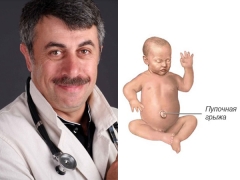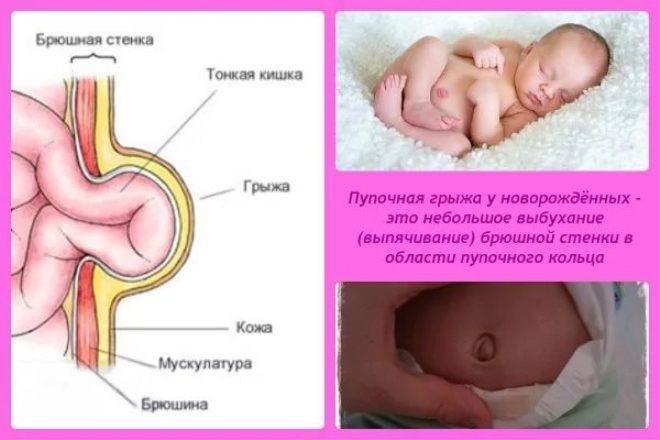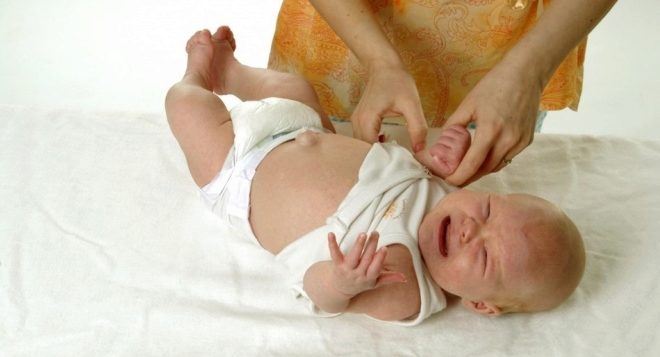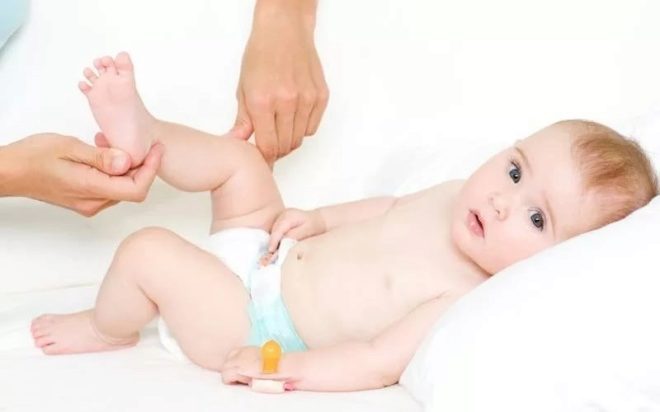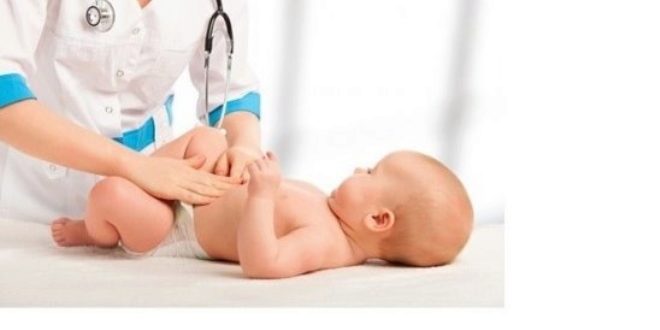Dr. Komarovsky about umbilical hernia in newborns and small children
Newly mummies are always marked by heightened anxiety. They react rather violently to the slightest changes in the state of their crumbs, and often sound the alarm on the most varied reasons. Precinct pediatricians sometimes add their own “five kopecks”, when visiting a newborn, reminding that the umbilical wound requires special attention, and then “suddenly umbilical hernia". About her confused and anxious moms often ask the famous pediatrician of the highest category and TV presenter Yevgeny Komarovsky.
What it is?
The umbilical hernia is a partial protrusion of the internal organs through the umbilical hole. Pathology in babies is quite common. Every fifth full-term infant and every third premature suffer from this disease. The causes of occurrence are varied - from congenital malformations to the non-cleavage of the umbilical ring, which may be the result of ineptly tied umbilical cord, a strong accumulation of gas in the intestine, constipation, strong and frequent prolonged crying.
The umbilical cord, which provides nutrition and oxygen to the baby during pregnancy after it is born, ceases to be necessary, normally after cutting off and bandaging, the umbilical cord becomes overgrown with connective tissue approximately one month after birth. But in some cases, the ring does not grow completely, and this causes the umbilical hernia or increases the risk of its occurrence.
A little later, the baby may experience a hernia due to the fact that his parents too early brought him upright.
Parents often notice a bulge in the navel in the minutes when the baby is screaming. However, in a quiet state, the tummy returns to normal, and the hernia is easily set back. However, the seed of doubt has already been sown, and moms and dads need to clarify the situation to them.
Evgeny Komarovsky explains that not every sticking navel is necessarily a hernia. Sometimes a convex navel is an individual feature of a little man, and there is nothing to worry about.
And in this issue of Dr. Komarovsky, one of the topics covered is precisely the case of an umbilical hernia.
A real umbilical hernia is palpable under the navel, only a doctor can determine its size and give predictions. In this case, the hernia will increase substantially in size when weeping, trying, coughing. If the diagnosis has already been made, and confirmed by the surgeon, do not panic. Komarovsky assures that this ailment is easy to cure in the shortest possible time, without resorting to surgical procedures.
Treatment
Evgeny Olegovich any talk about the umbilical hernia in newborns He begins by warning his parents against unauthorized treatment of the ailment with numerous folk remedies that can harm the crumbs much more than the hernia itself. He emphasizes that independently adjusting a hernia, dragging it with an elastic bandage is the right way to the surgical table. A notorious coin, which is often advised to apply to the hernia grandmother, and even some pediatricians, can cause an inflammatory process of the umbilical space.
So, if a child has a hernia, and doctors confirm this, then surgically eliminate only the most complex form of it - when the small intestine is pinched between the muscles. Usually surgery becomes possible when the child is 5 years old.Fortunately, such cases are more rare than the rule. All other types of umbilical hernia are treated without surgery if parents follow the recommendations. For many children, the ailment passes on its own as the abdominal wall grows and strengthens. Usually in 1 year of trouble with the navel is no longer observed. After a year, 95% of pediatric hernias dissolve.
If up to six months in a baby the hernia did not pass by itself, then it’s time, in the opinion of Komarovsky, to begin treatment. More precisely, parents must perform certain actions before the child is 6 months old.
Laying on belly
One of these techniques, which serves as an excellent prevention of umbilical hernia, and an effective treatment of existing problems, is laying out a baby on the tummy. It is advisable to do this for 15-20 minutes before feeding on a flat and hard surface.
During this exercise, the child strengthens the muscles of the abdominal wall, back, neck, shoulder girdle. In addition, lying on the stomach contributes to the discharge of gas from the intestine, reducing the intensity colic. The duration of the procedure should begin with 2-3 minutes, and gradually bring to 15 minutes. You can repeat before each feeding.
Massage
It can begin to do as soon as the umbilical wound heals and heals. Komarovsky emphasizes that such treatment will not require any special expenses from the family, because any mother and grandmother, and even the father, are able to master simple massage techniques. Movement and touch to the baby should be light, do not deliver negative emotions to the child. It is better to massage before meals to avoid regurgitation. It is better not to touch the hernia and the navel at all, to perform all the manipulations around them.
The simplest methods are stroking the tummy with fingertips in a clockwise direction with circular movements, light tapping and tingling in a circle around the navel, stroking the tummy with palms with oncoming movements. Each method is done on average 10 times.
This massage not only helps the abdominal wall to become stronger, but also helps to normalize the work of the intestine, relieves colic and gas.
Gymnastics
It can be done to children from 1 month. Komarovsky recommends combining exercises with massages. It is useful to practice coups from tummy to side, from back to side and back. To do this, the child should be given a grab for your fingers, sipping on the right handle, doing a revolution on the left side and vice versa. And also bring the legs, bent them with two hands in the knees and joining in the hip joint. Both legs synchronously press to the tummy for a few seconds, and then release, and then bring the legs one by one, right-left, the movement will resemble the actions of a cyclist.
Tips Komarovsky
Yevgeny Komarovsky reminds that massage, gymnastics and laying out on the tummy do not give instant results, but because parents should get ready for a long and systematic course, classes should not be missed, then you can forget about the umbilical hernia quite soon.
Not always a hernia is umbilical, sometimes it is inguinal, and more often this pathology occurs in boys under the age of two years than in girls. Or the diagnosis may sound differently - "hernia of the white line of the abdomen." In this case, the treatment is determined by the doctor depending on the degree of the affliction. That is why Komarovsky strongly recommends that you do not make diagnoses yourself, but it is imperative that you consult a specialist.
About ways of sticking umbilical hernia in a child with a plaster, Komarovsky responds quite categorically. Only the surgeon should perform the procedure for setting up a protruding hernia and its subsequent gluing, inept actions can harm the child. But even after everything has gone well, the baby should be carefully observed by specialists, because the hernia can increase in size, inflammation can begin under the plaster.
With relatively mild forms of umbilical hernia, a child can wear a special supporting bandage, you can buy it at any pharmacy or in an orthopedic salon.
